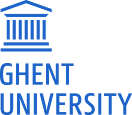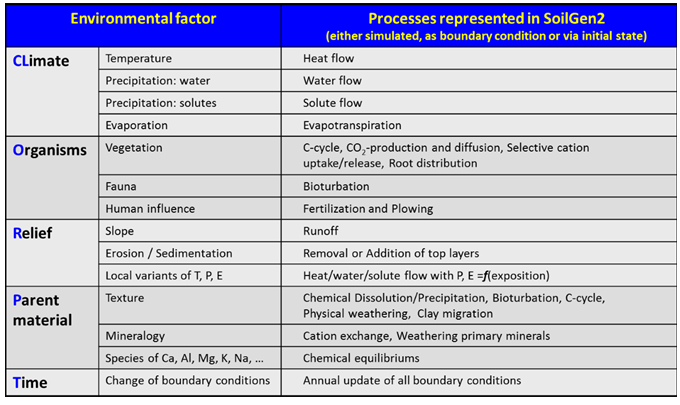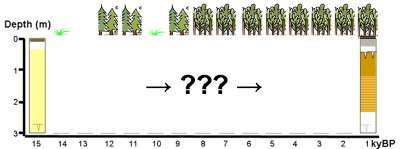
|
SoilGen is a (1-D) simulation model for the study of pedogenesis in various parent materials. Whereas most soil genetic studies take observations in the present to reconstruct soil development in the past, this model takes an initial soil or parent material as starting point and calculates the effect of various boundary conditions over long periods on soil development. Thus, Jenny’s paradigm is followed, which states that the soil we observe today is a function of the “factors of soil formation” CLORPT (CLimate, Organisms, Relief, Parent material and Time). All these factors are treated as boundary - or initial - conditions whereas the soil forming processes are part of the simulation model. So far, SoilGen was applied onto loess, cover sand, marine clay, weathering residuum and volcanic ash on sites in Belgium, France, Norway, China, Cameroon, U.S.A., Indonesia, Spain and Italy. SoilGen contains the processes physical weathering, chemical weathering, clay migration, (de-)calcification and (de-)gypsification, C-cycling and can deal with the effects of bioturbation, erosion, deposition, agricultural practices (fertilization, plowing, slash&burn) and several vegetation types. Podzolisation is not (yet) included. Fate of the elements C, Ca, Mg, Al, K, Na, Cl, H and S(ulphate) is simulated, and that of Fe, Si and Be is work in progress. |
|
Purpose |
|
Processes simulated in SoilGen |
|
Applications |

|
Soilgen model |
|
SoilGen has been applied in a number of case studies: · Finke and Hutson (2008) applied SoilGen1.1 to evaluate the effect of late-glacial to Holocene climate transitions on Hungarian and Belgian loess soils with special emphasis on the effect of bioturbation (climosequence research) (SoilGen1.1) · Finke (2012) applied it to a toposequence in loess in Belgium (SoilGen2.16); · Sauer et al (2012) applied it on two chronosequences in marine terraces in Norway (SoilGen2.16); · Yu et al (2013) calibrated the organic C-module for Chinese and Belgian loess forest soils; (SoilGen2.16); · Zwertvaegher et al, (2010) and Zwertvaegher et al. (2013) applied it on 96 locations in a coversand area to reconstruct soilscapes at prehistoric times in an archaeological context (SoilGen2.18); · Finke et al. (2013) applied it on 108 locations in highly variable loess soils to assess effects of terrain controls and treefalls on spatial patterns of soil horizons (SoilGen2.16). · Finke et al. (2015) calibrated and applied it on Loess soils under agriculture with special emphasis on lessivage (clay migration) (SoilGen2.24). Collaboration with INRA France; · Keyvanshokouhi et al. (2016) tested SoilGen for its capability to simulate global change scenarios. · Finke et al. (2017) applied SoilGen in combination with LOVECLIM to find causes for the differences between paleosoils from MIS5e and MIS13 · Finke et al. (2018) tested SoilGen in an uncertainty analysis of model-based landscape reconstruction for prehistoric land evaluation. Collaboration with Azam Jafari, Kerman University Iran; · Finke et al. (2018) related calibrated OC-decay rates to pedogenesis in a soil chronosequence in California. Collaboration with Emmanuel Opolot, Sebastian Doetterl and many others. · Ranathunga et al (2021a, 2021b, 2022) combined climate-soil modelling of paleosoils in the Chinese Loess Plateau (MIS1, 5e, 7, 9, 11, 13). · Anindita (in review) calibrated mineral weathering and SOC-decay to assess SOC-sequestration in volcanic soils in Indonesia under various land uses, and made RCP-projections.
Other activities: · Conversion of SoilGen2.24 to the VSoil modelling platform and testing alternative process formulations (PhD-project Saba Keyvanshokouhi, INRA France, 2018): PhD-thesis, OC-VGEN-paper. · Usage of SoilGen2.25 as a tool in a summer school on the modelling of soil genesis under global change (2020, 2022)
Ongoing studies: · Model calibration and testing on a 800.000 year paleosoil sequence in Baoji, China
Recent changes to Soilgen Added functionality in SoilGen2.24 (part of download): · Calculation of weathering indices as time/depth-diagrams (with Emmanuel Opolot) · Plowing depth and plowing intensity as non-mandatory annual inputs · Measured Van Genuchten parameters as non-mandatory annual layer input · Sequential runs are possible (for analysis of diverging scenarios after year X) · Calculation of Δ14C and estimation of Conventional Radiocarbon Age BP as time/depth-diagrams (thanks to Jerôme Balesdent and Christine Hatté) · Tillage variants: Inversion plowing and harrowing · Slash and burn events: input% of ectorganic matter that converts into IOM, HUM and atmosphere · Choice for either Richards equation or Addiscott mobile/immobile capacity system · Optional daily outputs (for selected variables) · Removed bug for sequential/continuation run · Prevention of potential numerical instability in CO2-diffusion routine SoilGen2.24 is not further developed. Run the executable “compatibility to Windows 7”
Added in SoilGen2.26 relative to vs.2.24 (part of download): · Improved routines for weathering of (19) minerals (with Emmanuel Opolot); · Prevention of potential numerical instability in CO2-diffusion routine; · Check on non-valid initial data; · Choice of bottom boundary condition(s) via GUI; · Optional choice and specification of decay rate modifiers of OC-pools; · Optional correction of the pF-curve for stony soils; · Calculation of pedogenic Fe and Si; · Improved User interface for modification of initial mineralogy; Compiled under Windows 10.
In development / ready but not yet released: · Behaviour of atmospheric 9Be/10Be / ready (model branch exists) · Architecture redesign · Model extension (sabbatical 2023): · Newformation of clay minerals · Physical and chemical protection of SOC · Water flow in stony soils · Adding routines for soil production from bedrock
DOWNLOADs · SoilGen1.1 and SoilGen2.16 still available on request. · SoilGen2.24 here (last build: 2.24.0.138 14/5/2018) and its user manual (2.24) here. I appreciate a mail if you’re using it. Check compatibility to Windows 7! · SoilGen2.26 here (build 2.261.0.1 6/3/2020, user manual here): detailed mineral weathering. I appreciate a mail if you’re using it. Runs under Windows 10. · Most recent version of output viewer (TDGraph) here and an animation viewer (TDAnim) here. Check compatibility to Windows 7! · Most recent version of (nonglossy) postprocessor (PostProc) here. Check compatibility to Windows 7! · A summary of data demands here.
Peer-reviewed publications on soilgen 1. Finke, P.A. and J. Hutson. 2008. Modelling soil genesis in calcareous löss. Geoderma 145 : 462-479. http://dx.doi.org/10.1016/j.geoderma.2008.01.017 2. Finke, P.A, 2012. Modeling the genesis of Luvisols as a function of topographic position in loess parent material. Quaternary International 265: 3-17. http://dx.doi.org/10.1016/j.quaint.2011.10.016 3. Daniela Sauer, Peter A. Finke, Isabelle Schülli-Maurer, Ragnhild Sperstad, Rolf Sřrensen, Helge I. Hřeg, Karl Stahr. 2012. Testing a soil development model against southern Norway soil chronosequences. Quaternary International 265: 18-31. http://dx.doi.org/10.1016/j.quaint.2011.12.018 4. Yu, Y.Y., Finke, P.A, Guo, Z.T, Wu H. B., 2013. Sensitivity analysis and calibration of a soil carbon model (SoilGen2) in two contrasting loess forest soils. Geoscientific Model Development 6, 29-44. www.geosci-model-dev.net/6/29/2013/ 5. Zwertvaegher, Ann, Peter Finke, Philippe De Smedt, Vanessa Gelorini, Marc Van Meirvenne, Machteld Bats, Jeroen De Reu, Marc Antrop, Jean Bourgeois, Philippe De Maeyer, Jacques Verniers, Philippe Crombé. 2013. Spatio-temporal modeling of soil characteristics for soilscape reconstruction. Geoderma 207-208: 166-179. http://dx.doi.org/10.1016/j.geoderma.2013.05.013 6. Finke, P.A., T. Vanwalleghem, E. Opolot, J. Poesen, J. Deckers. 2013. Estimating the effect of tree uprooting on variation of soil horizon depth by confronting pedogenetic simulations to measurements in a Belgian loess area. Journal of Geophysical Research - Earth Surface 118 (4): 2124–2139 . http://dx.doi.org/10.1002/jgrf.20153 7. Opolot E., Y.Y. Yu and P.A.Finke. 2015. Modeling soil genesis at pedon and landscape scales: achievements and problems. Quaternary International 376: 34-46 . http://dx.doi.org/10.1016/j.quaint.2014.02.017 8. Finke, P., Samouëlian, A., M. Suarez-Bonnet, B. Laroche and Cornu S. 2015. Assessing the usage potential of SoilGen2 to predict clay translocation under forest and agricultural land uses. European Journal of Soil Science 66(1): 194-205. http://dx.doi.org/10.1111/ejss.12190 9. Budiman Minasny, Peter Finke, Uta Stockmann, Tom Vanwalleghem, and Alex McBratney. 2015. Resolving the integral connection between pedogenesis and landscape evolution. Earth Science Reviews 150: 102-120. http://dx.doi.org/10.1016/j.earscirev.2015.07.004 10. Opolot, E., Finke, P.A. 2015. Evaluating sensitivity of silicate mineral dissolution rates to physical weathering using a soil evolution model (SoilGen2.25). Biogeosciences 12: 6791-6808. http://dx.doi.org/10.5194/bg-12-6791-2015 11. Keyvanshokouhi,S., Cornu S., Samouëlian A., Finke. P. 2016. Evaluating SoilGen2 as a tool for projecting soil evolution induced by global change. Science of the Total Environment 571: 110–123 . http://dx.doi.org/10.1016/j.scitotenv.2016.07.119 12. Peter A. Finke, Qiuzhen Yin, Nicholas J. Bernardini, and Yanyan Yu. 2017. Climate-soil model reveals causes of differences between MIS 5e and MIS 13 paleosoils. Geology. https://doi.org/10.1130/G39301.1 13. Peter A. Finke, A. Jafari, A. Zwertvaegher, O. Thas. 2018. Quantifying the uncertainty of a model-reconstructed soilscape for archaeological land evaluation. Geoderma 320C: 74-81 https://doi.org/10.1016/j.geoderma.2018.01.032 14. Peter Finke, Emmanuel Opolot, J. Balesdent, Asmeret Asefaw Berhe, Pascal Boeckx, Sophie Cornu, Jennifer Harden, C. Hatté, Sebastian Doetterl 2018. Can SOC modelling be improved by accounting for pedogenesis? Geoderma. https://doi.org/10.1016/j.geoderma.2018.10.018 15. Finke, P.A., Ranathunga, N., Verdoodt, A., Yu, Y.Y. and Yin, Q.Z. 2021. Unraveling loess records of climate change from the Chinese loess plateau using process-based models. In: Hunt, A, Egli, M (eds). Hydrogeology, Chemical Weathering and Soil Formation. AGU special publication. https://dx.doi.org/10.1002/9781119563952.ch8 16. Keerthika Nirmani Ranathunga, Peter A. Finke, Qiuzhen Yin, Ann Verdoodt, YanYan Yu. Soil modeling for soil loss tolerance estimations: exploring natural baselines and long-term variations. 2021 Global and Planetary Change 103548. https://doi.org/10.1016/j.gloplacha.2021.103548 17. Keerthika N. Ranathunga, Peter A. Finke, Qiuzhen Yin, Yanyan Yu. 2021. Calibrating SoilGen2 for interglacial soil evolution in the Chinese Loess Plateau considering soil parameters and the effect of dust addition rhythm. Quaternary International. https://doi.org/10.1016/j.quaint.2021.08.019 18. Finke, P.A., Minasny, B, Temme, A.J.A.M. 2022. Modeling Soil Development in a Landscape Context. Encyclopedia of Soils in the Environment, Second Edition. https://doi.org/10.1016/B978-0-12-822974-3.00005-7 19. Vanesa García-Gamero, Tom Vanwalleghem, Adolfo Peńa, Andrea Román-Sánchez, and Peter A. Finke. 2022. Modelling the effect of catena position and hydrology on soil chemical weathering. SOIL 8, 319–335 https://doi.org/10.5194/soil-8-319-2022 20. Keerthika Nirmani Ranathunga, Peter A Finke, Qiuzhen Yin, Zhipeng Wu, Qingzhen Hao, Hao Lu. 2023. Driving factors of interglacial paleosol formation on the Chinese Loess Plateau and the effect of precession and ice sheets. Quaternary Science Reviews. https://doi.org/10.1016/j.quascirev.2022.107911 21. Sastrika Anindita, Steven Sleutel, Peter Finke. In review. Simulating soil organic carbon stock as affected by land use and climate change on volcanic soil in Indonesia. * Disclaimer SoilGen is a research model and so far it has been applied on 100’s of scenarios and sites. For non-plausible inputs SoilGen may provide nonsults and might leave your PC in distress. It is my experience that 95% of the crashes are caused by invalid inputs. SoilGen is not meant for peat soils and clay soils. Opolot et al. (2015) give an application domain |

